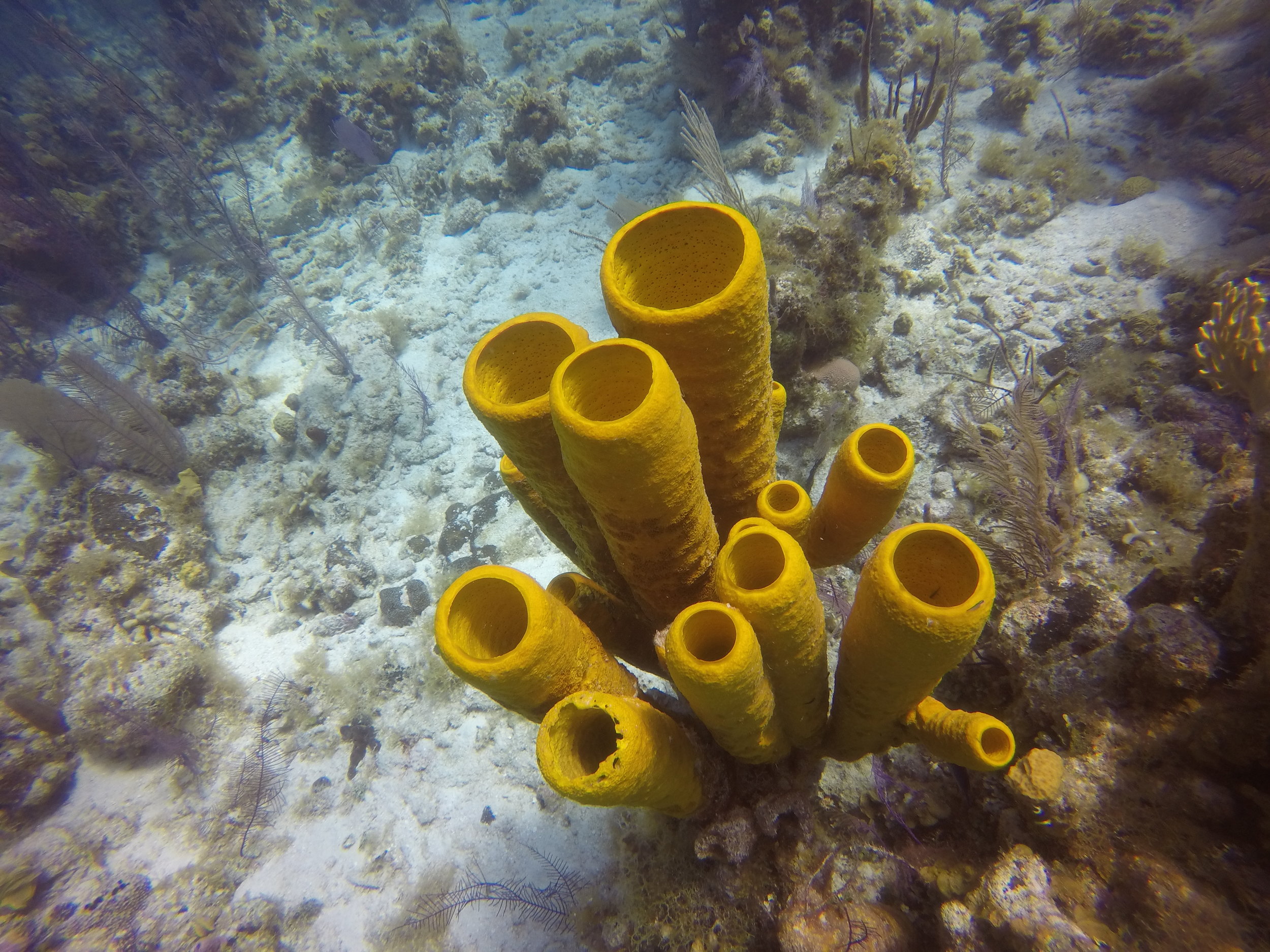ABOUT DIVING Belize
Belize is the northern most country in Central America and the only one that does not border the Pacific Ocean. It only borders the Caribbean Sea. It has an international airport which serves 11 airlines originating from the US, Canada, Mexico, and other Central American nations. For the scuba enthusiasts, Belize is the home to three of the four atolls in the Western Hemisphere: Glover’s Reef, Lighthouse Reef and Turneffe Atoll. It also shares nearly 200 miles of a beautiful coastline with The Meso-American Barrier Reef (also called “Great Mayan Reef” or locally “the Belize Barrier Reef”) - the longest barrier reef in the northern hemisphere. This 620-mile-long reef stretches from Isla Mujeres (near Cancun Mexico) in the north to the Bay Islands of Honduras to the south. The atolls and the reef, along with hundreds of sand cayes, coastal lagoons, estuaries, and mangrove forests, together make up the Belize Barrier Reef Reserve System. This reef system is home to more than 50 species of coral, over 500 species of fish, and hundreds of mollusk types. Belize is also the home of the famous Blue Hole and Half Moon Caye, two must-do major attractions for any diver wanting to visit this fabulous paradise. Belize diving is made better by the nearly perfect water temperatures of between 80-86F all year. This dive destination is perfect for the experienced diver, the beginners who want to try scuba diving, or the person that desires to get their scuba certification.
Best Dive Sites in Belize
Ambergris Caye
This is the biggest of the offshore Belizean Cayes. It is the perfect place to stay if you wish to be close to the many dive sites of the reef system. Belize diving from Ambergris Caye is simple. The Caye sits less than a half mile away from the shore, for nearly its entire 28-mile length. The proximity to the reef means that most dive sites are only a 5- to 10-minute boat ride away, and most dive boat operators will bring divers back to their dive shop dock for the surface interval between dives.
The formation of the reef is primarily long coral fingers that jut out on the ocean side. These are known as 'spur and groove' reefs and run perpendicular to the coastline. These finger rolls provide a large number of caverns, tunnels, gullies, and ledges. This special reef structure, and the abundant marine life, provides much for scuba divers to explore.
Local divers see many varieties of marine life including small and large reef fish, turtles, sharks, manatees, dolphins, rays, eels, sponges, fans, and so much more. Some of the most popular local dive sites include Tackle Box where reef sharks and the occasional bull shark make for an interesting dive. Love Tunnels has some grand and “romantic” swim throughs, and Mata Canyons, which is a perfect 2nd dive with its beautiful coral formations, a lot of queen conchs, which attract eagle rays and, of course, the ever-present nurse sharks. Ambergris Caye is close to at least 40 interesting dive sites, and marine life, to help beginners build interest and make experienced divers thrilled. In addition, Ambergris Caye is also close to the Hol Chan Marine Reserve.
HOL CHAN MARINE RESERVE
Hol Chan is located at a cut in the reef and means “little channel” in Mayan. It is often used as a way of accessing the dive sites located outside of the barrier reef south of San Pedro, and is at the center of the Hol Chan Marine Reserve. This marine park is protected and guarded against anchoring, touching of the coral, and reef fishing. As such, this area of the barrier reef is in excellent health and full of marine life with tall sections of Elkhorn corals. Hol Chan is popular with divers and snorkelers, but note at this location, there are strong currents. Night dives are frequently done here, by day or night, you’ll find snapper, grouper, jacks, barracuda, rays and much, much more.
THE ATOLLS
Belize is home three out of the four true coral atolls found in the western hemisphere. Heading east-southeast from Ambergris Caye, or east from Belize City, you will find Turneffe Atoll, Lighthouse Reef and Glover’s Reef. Atolls are essentially submerged round corals with some dry land surrounding them. If you desire a dive holiday at a place where there are few people and it’s all about diving, then the small resorts at the atolls might be the perfect locations for you. Alternatively, there are many dive shops operating out of Ambergris Caye, Caye Caulker, or Belize City that can get there in just 2 hours or less. The reefs in and around these atolls drop off into the deep. The marine life here is truly magnificent. Diver’s will find shallow gardens, vertical walls, canyons with beautiful swim throughs and marine life of all kinds.
Turneffe Atoll is the largest of the three and the closest to the mainland. One of the best dive sites found here is known as Elbow. It is located at the southern tip, and with a large bend in the coral, it is extraordinary site to behold. The furthest from the mainland, of the three atolls, is Lighthouse Reef which circles a 30-mile long lagoon, and where Half Moon Caye and the Great Blue Hole are located. Glover’s Reef is the most distant of the three atolls and, as a result, is the least toured by scuba divers. As a result, the 50 miles of this reef have hardly been visited and the marine life is extraordinary. The atolls are plentiful and seldom overly populated which makes them some of the best Belize dive sites!
The atolls may be the best diving in Belize (and in this hemisphere!). This is an all day dive experience and should be done as one of your dive days, if at all possible.
THE BLUE HOLE
The Blue Hole should be on every diver’s bucket list. You can’t talk about Belize and diving without mentioning the famous Blue Hole. This giant sink hole is nearly 1,000 feet across and almost 400 feet deep. It is a 2.5-hour boat ride from San Pedro, but worth the time and cost. This extraordinary dive site was made famous by Jacques Cousteau when he brought his research ship to investigate the sinkhole in 1972, where he found, to his surprise, submerged stalactites. The conclusion that Cousteau and his team reached was that the sinkhole was formed before the seas rose.
The dive profile is as follows: first, descend to +/- 138 feet. You won’t see much marine life, at that level, although a few reef sharks and an occasional hammer head may surprise you, but the amazing swim throughs of stalactites for a short eight minutes will take your breath away (not literally of course). You will then take your time ascending along a different route, and enjoy an extra-long safety stop of 10-15 minutes. This deep dive adventure will entice any diver coming to Belize.
PLACENCIA
Placencia is a southern Belize coastal town, with a charm all its own. One of the main draws of visiting here is the opportunity to dive with whale sharks, the largest fish in the ocean. Whale sharks can often be found offshore in late spring, or early summer, in nearby Gladden Spit. Whale sharks migrate through this area when many different species of fish are spawning, even though the main diet of whale sharks consists of plankton. They will, however, also consume the large Cubera Snapper eggs. During this migration period, the whale sharks are typically relaxed, offering many chances for divers to swim alongside and video these magnificent creatures.
Best TIME to dive in Belize
The weather is nearly perfect year round for scuba diving. September and October are the two “rainy season” months, although rain usually doesn’t interfere with dive plans as winds and sea conditions might do. The water temperature varies little. The coldest water temps are 80F in Nov/Jan/Feb, while the warmest water temps are 85-86F in Jun thru Oct. All in all, perfect dive conditions exist nearly all year round with wetsuits optional. For us the answer to the question “when to dive in Belize” is whenever we get the chance!
scuba diving trip tips
We suggest booking your dives a week or two before heading down. This may not always be necessary but better to be safe than sorry that your preferred dive shop has room on the boat for you. If you are planning on getting scuba certified while here, absolutely get that booked in advance. You can bring your own gear or rent part, or all, of your gear while here, everything you need will be available. If your passions include underwater photography or videography you’ll want to bring your own equipment. The charging equipment will work perfectly here and most rooms have safes for nighttime storage. Oh, and please pack light. You wont need much in the way of clothes and appliances.
Snorkeling in Belize
For those more inclined to snorkel than dive, the opportunities for snorkeling are nearly endless in Belize. From the beaches of nearly every Caye, one can walk out and snorkel over one of the world’s most beautiful coral reefs. From San Pedro, Ambergris Caye snorkeling, we’d recommend Hol Chan Marine Park and with the nearby sharks and ray at Shark Ray Alley. These are two of the most perfect snorkeling adventures. Also, nearby to San Pedro is outstanding snorkeling at Mexico Rocks and Coral Gardens. And, if you are interested in a magnificent all day snorkel, fishing, and touring adventure, Bacalar Chico is a wonderful trip “around" the Caye!
Dive resorts and dive shops
There are about a dozen full service dive resorts spread throughout the Belizean Caribbean. Dive shops are far too numerous to count. By far the largest concentration of dive shops will be found on Ambergris Caye. This includes two large dive operations and several dozen small operators. We have personal dive experience with most reputable dive shops and enjoy both the large and small operators. There are so many choices. We'd be happy to recommend the right shop for you and your dive group.
DIVE TOURS AND DEALS
Ready to plan your diving or snorkeling adventure? See diving and snorkeling deals here.













